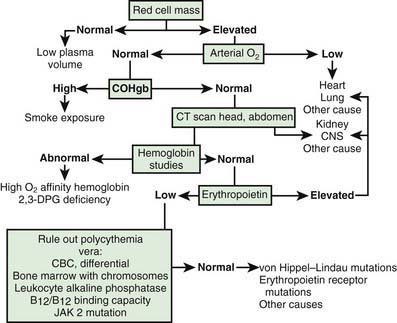Chapter 460 Polycythemia
Polycythemia exists when the red blood cell (RBC) count, hemoglobin level, and total RBC volume all exceed the upper limits of normal. In postpubertal individuals, an RBC mass > 25% above the mean normal value (based on body surface area), or a hematocrit level > 60 (in males) or > 56 (in females) indicate absolute erythrocytosis. A decrease in plasma volume, such as occurs in acute dehydration and burns, may result in a high hemoglobin value. These situations are more accurately designated as hemoconcentration or relative polycythemia because the RBC mass is not increased and normalization of the plasma volume restores hemoglobin to normal levels. Once the diagnosis of true polycythemia is made, sequential studies should be done to determine the underlying etiology (see ![]() Fig. 460-1 on the Nelson Textbook of Pediatrics website at www.expertconsult.com).
Fig. 460-1 on the Nelson Textbook of Pediatrics website at www.expertconsult.com).

Figure 460-1 Sequential studies to evaluate polycythemia. CBC, complete blood count; CNS, central nervous system; COHgb, carboxyhemoglobin; 2,3-DPG, 2,3-diphosphoglycerate.
Primary Polycythemia (Polycythemia Rubra Vera)
Pathogenesis
Polycythemia vera is a clonal panmyeloproliferative disorder and is rare in children. A gain of function mutation of JAK2, a cytoplasmic tyrosine kinase, has been found in 75% of adult patients with polycythemia vera but in a much lower percentage of children with this condition. The erythropoietin receptor is normal, and serum erythropoietin levels are normal or low.
In vitro cultures do not require added erythropoietin to stimulate growth of erythroid precursors. Diagnostic criteria for polycythemia vera were revised by the WHO in 2008 and are listed in Table 460-1.
Stay updated, free articles. Join our Telegram channel

Full access? Get Clinical Tree


